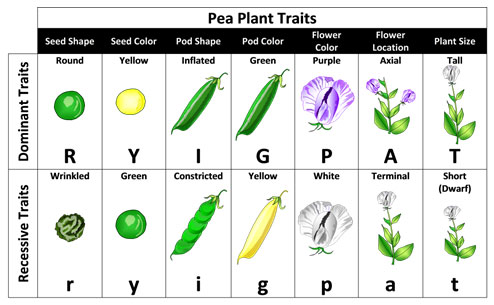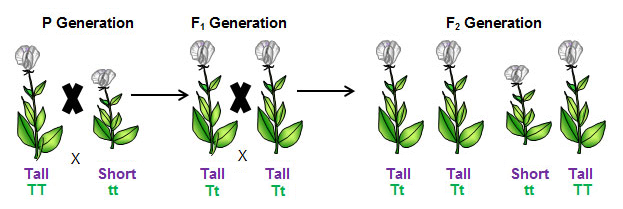Some plants reproduce sexually. In the lesson titled “Heredity and Inherited Traits,” you learned about Gregor Mendel and the research he conducted with pea plants. Pea plants are flowering plants and reproduce sexually. The flower of a pea plant contains both the male and female sex organs.
The female reproductive structures are called carpels. In most flowers, the carpels are fused together to form a pistil. The pistil is made up of three parts: stigma, style, and ovary. The male reproductive structure is called the stamen. Each stamen has two parts: anther and filament. In plants, a female sex cell is referred to as an egg, and the male sex cell is referred to as pollen.
![]() Click on each word in the image below to learn more about the structure of a flower.
Click on each word in the image below to learn more about the structure of a flower.
Remember that Mendel noticed that when he crossed a true breeding plant with one characteristic, such as purple flowers, with a true breeding plant with the opposite characteristic, such as white flowers, one trait hid or masked the other characteristic.
Mendel concluded that there must be two forms of the same gene for each trait he studied.

Different forms of the same gene are called alleles. When one trait is “stronger” than the other trait, the “stronger” trait is called the dominant trait or allele, and the one that is hidden is called the recessive trait or allele.
A capital letter is used to represent the dominant form of an allele or gene, and a lower case letter is used to represent the recessive form of an allele or gene. In general, the first letter of the dominant trait is used to determine the symbol. For example, in pea plants, tall is the dominant trait for plant height so T would be used for tall and t for short.
The traits that Mendel studied would use the letter system as shown in the chart below.

Source: Pea Plant Characteristics, Mariana Ruiz, Wikimedia Commons
When biologists describe the traits of an organism, they are refereeing to the organism’s phenotype. For example, for seed color, a pea plant can display a phenotype of yellow or green. The genotype is the actual genetic makeup of an organism. In other words, the forms of the alleles of a gene it contains.
An organism could have the following genotypes:
| Forms of alleles | Example | Genotype | Phenotype Expressed |
| two dominant alleles (two capital letters) |
TT | homozygous dominant | dominant trait |
| two recessive alleles (two lowercase letters) |
tt | homozygous recessive | recessive trait |
| one dominant and one recessive allele (one capital and one lower case) |
Tt | heterozygous or hybrid | dominant trait |
Mendel called true breeding homozygous dominant and homozygous recessive. In the diagram below, the phenotype is shown in purple, and the genotype is shown in green.


Source: Reginald Crundall Punnett, DNA from the Beginning
Predicting the genotypes and phenotypes of an offspring in genetic crosses can sometimes be difficult. A Punnett square is a graphic organizer that can simplify the process. Punnett squares use probability to help determine the possible genotypes and phenotypes combinations in a genetic cross.
A British geneticist, Reginald Punnett, created the technique in 1905.
![]() Watch the following video that discusses how to set up a Punnett square.
Watch the following video that discusses how to set up a Punnett square.
Source: How to Draw a Punnett Square, MahaloBiology, YouTube